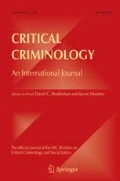Abstract
This article traces Jock Young’s contribution to the development of Left Realist criminology beginning with the political interventions of the mid 1980s progressing through the development of the ‘square of crime’ as the conceptual framework for a Left Realist research programme to some of the final formulations in his later works. The emphasis of the article is less on critical receptions of Left Realism by the wider criminological community than on demonstrating the consistency of Jock’s commitment to following through the implications of the Left Realist paradigm.
Similar content being viewed by others
References
Bauman, Z. (2000). Liquid modernity. Cambridge, UK : Malden, MA: Polity Press.
Brogden, M. (1982). The police: Autonomy and consent. London: Academic Press.
Coleman, A. (1985). Utopia on trial. London: Hilary Shipman.
Cornish, D., & Clarke, R. (1986). The reasoning criminal: Rational choice perspectives on offending. New York: Springer.
Currie, E. (1985). Confronting crime: An American challenge. New York: Random House.
Ferrell, J., Hayward, K., & Young, J. (2008). Cultural criminology: An invitation. London: Sage.
Fitzgibbon, D. (2007). Institutional racism, pre-emptive criminalisation and risk analysis. Howard Journal of Criminal Justice, 46, 128–144.
Fraser, N. (1997). Justice interruptus: Critical reflections on the ‘post Socialist’ condition. New York: Routledge.
Gamble, A. (1988). The free economy and the strong state. London: Macmillan.
Garland, D. (2001). The culture of control: Crime and social order in contemporary society. Oxford: Oxford University Press.
Hall, S., Critcher, C., Jefferson, T., Clarke, J., & Roberts, B. (1978). Policing the crisis: Mugging, the state and law and order. London: Macmillan.
Harcourt, B. (2001). Illusion of order: The false promise of broken windows policing. Cambridge, MA: Harvard University Press.
Hopkins Burke, R. (2005). An introduction to criminological theory. Cullompton: Willan.
Hough, M., & Mayhew, P. (1983). The British crime survey: First report. London: HMSO. Home Office Research Study76.
Jacobs, J. (1961). The death and life of great American cities. New York: Random House.
Jones, T., MacLean, B., & Young, J. (1986). The Islington crime survey: Victimization and policing in inner-city London. Aldershot: Gower.
Kinsey, R. (1984). First report of the Merseyside crime survey. Liverpool: Merseyside County Council.
Kinsey, R., Lea, J., & Young, J. (1986). Losing the fight against crime. Oxford: Blackwell.
Lea, J. (1992). Left realism: A framework for the analysis of crime. In J. Young & R. Matthews (Eds.), Rethinking criminology: The realist debate. London: Sage.
Lea, J. (1997). Postfordism and criminality. In N. Jewson & S. MacGregor (Eds.), Transforming cities: Contested governance and new spatial divisions (pp. 42–55). London: Routledge.
Lea, J. (2002). Crime and modernity. London: Sage.
Lea, J. (2014). New deviancy, Marxism and the politics of left realism: Reflections on Jock Young’s early writings. Theoretical Criminology, 18(4), 432–440.
Lea, J., & Young, J. (1982). The riots in Britain 1981: Urban violence and political marginalisation. In D. Cowell, T. Jones, & J. Young (Eds.), Policing the riots (pp. 5–21). London: Junction Books.
Lea, J., & Young, J. (1984). What is to be done about law and order?—Crisis in the Eighties. Harmondsworth: Penguin.
MacLean, B., & DeKeseredy, W. S. (1990). Taking working class victimization seriously: The contribution of Left Realist surveys. The International Review of Modern Sociology, 20(2), 211–228.
Matthews, R. (1992). Replacing broken windows: Crime, incivilities and urban change. In R. Matthews & J. Young (Eds.), Issues in realist criminology (pp. 19–50). London: Sage.
Matthews, R. (2009). Beyond ‘so what?’ criminology: Rediscovering realism. Theoretical Criminology, 13, 341–362.
Newman, O. (1973). Defensible space: People and design in the violent city. London: Architectural Press.
Osborn, S., & Shaftoe, H. (1995). Successes and failures in neighbourhood crime prevention. Housing Research, York: Joseph Rowntree Foundation.
Overbeek, H. (1990). Global capitalism and National decline: The Thatcher decade in perspective. London, Boston: Unwin Hyman.
Skogan, W. (1988). Disorder, crime and community decline. In T. Hope & M. Shaw (Eds.), Communities and crime reduction. London: HMSO.
Taylor, I., Walton, P., & Young, J. (1973). The new criminology: For a social theory of deviance. London: Routledge.
Wacquant, L. (2009). Punishing the poor: The neoliberal government of social insecurity. Durham, NC: Duke University Press.
Wilson, J. Q., & Kelling, G. F. (1982). Broken windows: The police and neighborhood safety. Atlantic Monthly, 249(3), 29–38.
Yar, M., & Penna, S. (2004). Between positivism and post-modernity?: Critical reflections on Jock Young’s The exclusive society. British Journal of Criminology, 44(4), 533–549.
Young, J. (1971). The drugtakers: The social meaning of drug use. St. Albans: Paladin.
Young, J. (1975). Working class criminology. In I. Taylor, P. Walton, & J. Young (Eds.), Critical criminology (pp. 63–94). London: Routledge and Kegan Paul.
Young, J. (1979). Left idealism, reformism and beyond: From new criminology to Marxism. In B. Fine, R. Kinsey, J. Lea, S. Picciotto, & J. Young (Eds.), Capitalism and the rule of law: From deviancy theory to Marxism (pp. 1–28). London: Hutchinson.
Young, J. (1986). The failure of criminology: The need for a radical realism. In R. Matthews & J. Young (Eds.), Confronting crime (pp. 4–30). London: Sage.
Young, J. (1987). The tasks of a realist criminology. Contemporary Crises, 11(4), 337–356.
Young, J. (1991). Left realism and the priorities of crime control. In: K. Stenson & D. Cowell (Eds.), The politics of crime control (pp. 146–160). London: Sage.
Young, J. (1992). Ten points of realism. In J. Young & R. Matthews (Eds.), Rethinking criminology: The realist debate (pp. 24–68). London: Sage.
Young, J. (1999). The exclusive society: Social exclusion, crime and difference in late modernity. London: Sage.
Young, J. (2007). The vertigo of late modernity. London: Sage.
Young, J. (2011). The criminological imagination. Cambridge: Polity Press.
Author information
Authors and Affiliations
Corresponding author
Rights and permissions
About this article
Cite this article
Lea, J. Jock Young and the Development of Left Realist Criminology. Crit Crim 23, 165–177 (2015). https://doi.org/10.1007/s10612-015-9273-8
Published:
Issue Date:
DOI: https://doi.org/10.1007/s10612-015-9273-8




